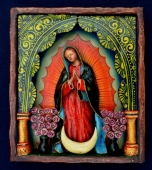Since the first known representation of the Madonna, found in the catacombs of Rome and believed to have been painted in the second century A.D., the portrayal of her physical characteristics have been widely varied. Though images of ivory- skinned madonnas often pop readily to Western minds, there are over four hundred “officially recognized” Black Madonnas. These Black Madonnas are considered by academics to be aa type of Marian statue or painting of mainly medieval origin (12C-15C), of dark or black features whose exact origins are not always easy to determine, and most important, of particular prominence. The latter, the prominence of the Black Madonna, is mostly due to the allegedly miraculous character of the image. Read the article by Michael P. Duricy here:
http://campus.udayton.edu/mary/meditations/blackmdn.html
In the New World, two “Black Madonnas” have special significance, though both have their roots firmly planted in Europe. Our Lady of Guadalupe, the Mother of the Americas, was the dark-skinned image that appeared on the cloak of a poor indigenous man that Mary visited on a hilltop in Mexico in 1531. She came to be called, “Guadalupe” because of her similarity in origin to an earlier Black Madonna, Santa Maria de Guadalupe in Caceres, Spain. That Madonna was a wooden figure that had reputedly been carved by St. Luke and given to the Archbishop of Seville. During the 8th century Moorish invasion, the statue was hidden and remained so during the years of occupation. Seven hundred years later, a cowherd by the name of Gil Cordero was visited by the Virgin Mother. The cowherd ran to the priests and told them to dig at the site of his vision. There they found the long-lost sacred statue, now blackend after its years of “entombment.” A shrine was quickly erected, which grew over time to become the Royal Monastery of Santa Maria de Guadalupe in Extramadura, Spain.
St. Luke was also the reported creator of “Our Lady of Jasna Gora,” a Black Madonna on canvas which he painted on a cedar table belonging to the Holy Family
. The painting was “discovered” by St. Helen in Constantonople in Jerusalem in 326 and worked its way over the next eleven centuries to Jasno Gora Monastery in Czestochowa, Poland via Constantinopole and Belz, Ukraine. It is this image of Mary that Polish soldiers, fighting on both side of the Haitian Revolution, brought to the Caribbean. There, black slaves and free men embraced her as their own. In Haiti, Our Lady of Jasna Gora was absorbed into Voodoo culture and became associated with the Voodoo spirit, Erzulie Dantor. See Blog:here:https://www.itscactus.com/blog/2013/04/10/erzulie-dantor-the-fierce-mother/
In both cases, the arrival of Black Madonnas on New World shores resonated with local populations. They recognized her as the Universal Queen. To them, her message was clear: “Am I not here with you as your Mother? Are you not under my shadow and protection? Surely you recognize me, for I am of your kind.”
Contributed by Linda for It’s Cactus


